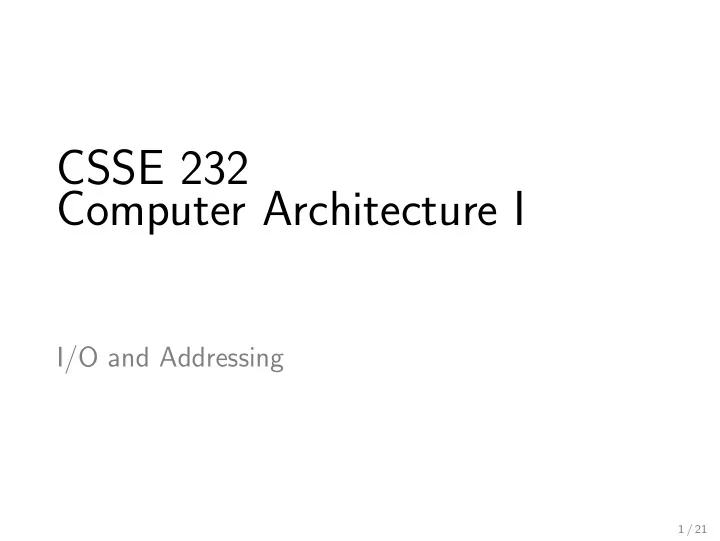

CSSE 232 Computer Architecture I I/O and Addressing 1 / 21
Class Status Reading for today • 2.9-2.10, 6.6 (optional) 2 / 21
Outline • I/O • More memory instructions • Addressing modes • Jump and branch instructions 3 / 21
Input and Output • How the processor communicates with the outside world • Input • Keyboard • Mouse • Network card • Output • Display / Graphics card • Printer • Network card • Sound card 4 / 21
Performing I/O • I/O port • I/O devices are assigned to an I/O port • Use specific I/O instructions to access I/O ports • Memory-mapped I/O • Reserve a portion of memory space for device I/O • Use regular memory instructions to access 5 / 21
I/O ports • I/O devices are assigned a port ID • CPU has special instructions to read and write to I/O ports • Data can then be sent and received by devices 6 / 21
Memory Mapped I/O • Designate a portion of memory space to be for I/O • Device memory and registers are mapped to this space • Use normal memory instructions to read and write data • A special piece of hardware monitors memory operations • If regular memory space is accessed • Read and write as normal • If I/O space is accessed • Intercept memory read/write • Redirect to actual device memory • I/O mapping can be disabled and addresses revert to regular memory 7 / 21
Polling and Interrupts • Polling • Devices set flag indicating they need to send/receive data • Processor frequently polls devices • Checks if any I/O devices need attention, responds • Interrupt • Device set interrupt flag and special status register • Processor is forced to stop executing normal code • Jumps to special interrupt handling code • Responds to device interrupt 8 / 21
More Memory Instructions • MIPS can work with other memory sizes: bytes, shorts • lb : load byte into lowest register byte • sb : store lowest register byte into memory • lh : load half into bottom register half • sh : store lower register half into memory • ld : load double word • sd : store double word • Upper bits are sign extended 9 / 21
J-Type • Last instruction type • Used for jumps • Jump only needs an address • No other values op (6) target (26) 10 / 21
Addressing Modes Related instructions • ori • addi • jr • lw • sw • beq • bne • j 11 / 21
PC-Relative Addressing • Branch address calculated as 1 Sign extend instruction constant 2 Shift left 2 times (multiply by 4) 3 Sum result with PC (actually PC+4) • Allows branching within ± 2 15 instructions • Example: beq, bne 4. PC-relative addressing op rs rt Address Memory PC + Word 12 / 21
Program Counter (PC) • Special register that points to current instruction • jal saves PC+4 into $ ra 13 / 21
Direct Addressing (also called Register) • Register value allows access to 2 32 locations/values • Example: jr 2. Register addressing op rs rt rd . . . funct Registers Register 14 / 21
Pseudo-Direct Addressing • Jump address is calculated as 1 Take 26 bits from instruction constant 2 Shift left 2 times (multiply by 4) 3 Concat top 4 bits of the PC as MSBs • Allows branching to 2 26 instructions • Example: j 5. Pseudodirect addressing op Address Memory PC Word 15 / 21
Immediate Addressing • Operand is a constant within the instruction • Some instructions sign extend (addi, slti) • Some zero-extend (ori, andi, sltiu) • Allows access to values in range [0 , 2 16 ) or [ − 2 15 , 2 15 ) 1. Immediate addressing op rs rt Immediate 16 / 21
Base / Displacement Addressing • Memory address calculated as 1 Sign extend instruction constant 2 Add to register value • Register allows access to 2 32 locations • Constant allows access to ± 2 15 locations relative to base • Require word (4 byte) alignment: lw, sw 3. Base addressing op rs rt Address Memory Register + Byte Halfword Word 17 / 21
Example What would be the machine language equivalent (in decimal) of the following code? Assume the Loop code starts on location 80000 in memory. Loop : s l l $ t1 , $ s3 , 2 add $ t1 , $ t1 , $ s6 lw $ t0 , 0( $ t1 ) bne $ t0 , $ s5 , Exit addi $ s3 , $ s3 , 1 j Loop Exit : 18 / 21
Example addr instruction format 80000 0 0 19 9 2 0 80004 0 9 22 9 0 32 80008 35 9 8 0 80012 5 8 21 2 80016 8 19 19 1 80020 2 20000 19 / 21
Branching Far Away • What would you change if the bne statement needed to branch to 2 21 instructions before or after the branch? • What would you change if the bne statement needed to branch to 2 30 instructions before or after the branch? 20 / 21
Branching Far Away • What would you change if the bne statement needed to branch to 2 21 instructions before or after the branch? • What would you change if the bne statement needed to branch to 2 30 instructions before or after the branch? • Have the bne go to a beq , resulting in up 2 ∗ 2 15 distance • Have the bne go to a j , for a distance of 2 15 + 2 26 • Load the goal address in a register and have the bne go to a jr 20 / 21
Review and Questions • I/O • More memory instructions • Addressing modes • Jump and branch instructions 21 / 21
Recommend
More recommend